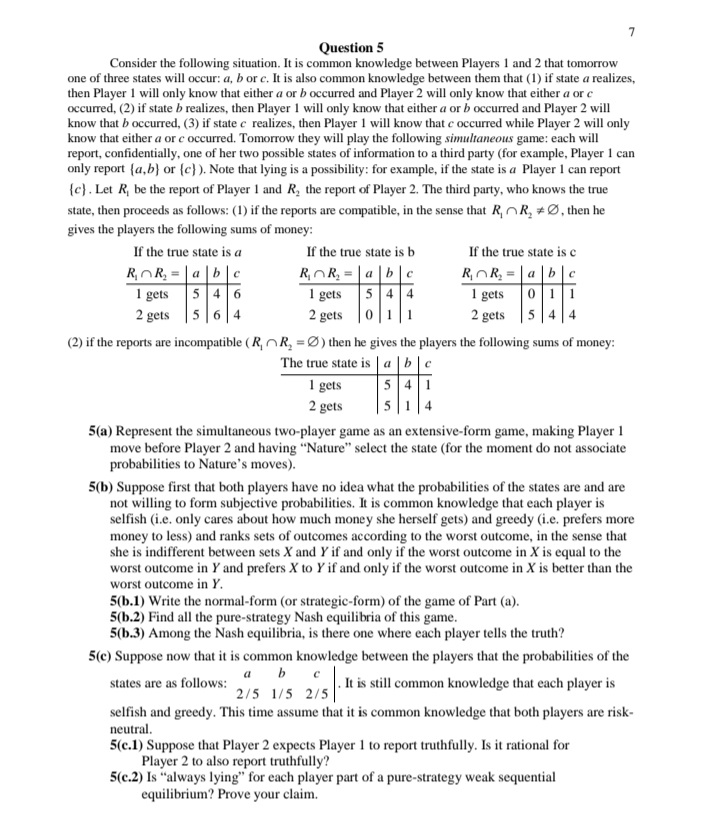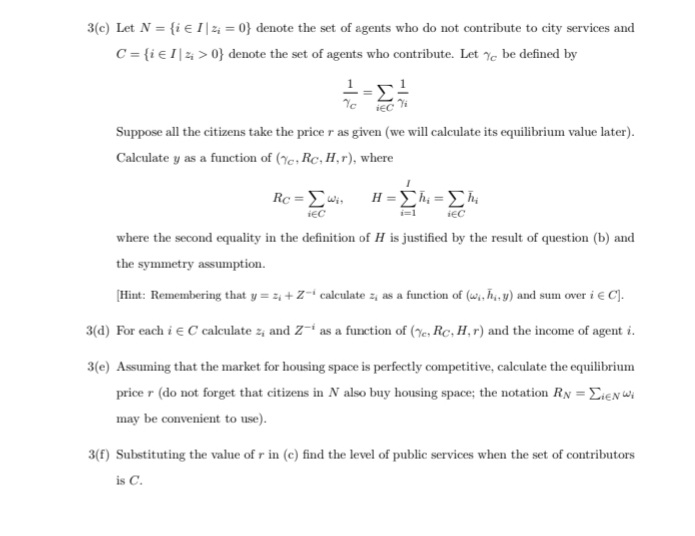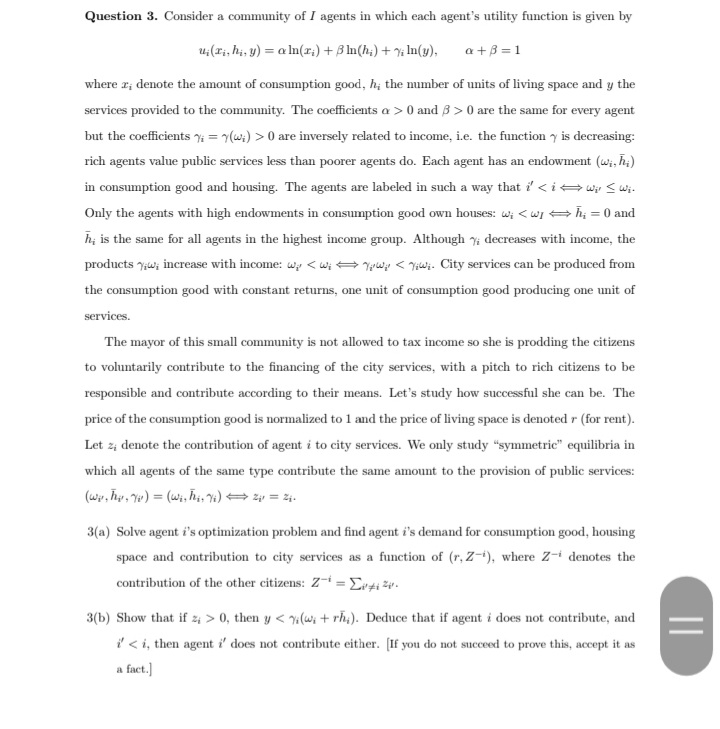



questions:
Question 5 Consider the following situation. It is common knowledge between Players I and 2 that tomorrow one of three states will occur: a, b or c. It is also common knowledge between them that (1) if state a realizes, then Player I will only know that either a or b occurred and Player 2 will only know that either a or c occurred, (2) if state b realizes, then Player I will only know that either a or b occurred and Player 2 will know that b occurred, (3) if state c realizes, then Player I will know that c occurred while Player 2 will only know that either a or c occurred. Tomorrow they will play the following simultaneous game: each will report, confidentially, one of her two possible states of information to a third party (for example, Player I can only report {a,b} or (c) ). Note that lying is a possibility: for example, if the state is a Player I can report (c) . Let R, be the report of Player I and R, the report of Player 2. The third party, who knows the true state, then proceeds as follows: (1) if the reports are compatible, in the sense that R, OR, # @, then he gives the players the following sums of money: If the true state is a If the true state is b If the true state is c ROR = abc ROR, = abc ROR = abc 1 gets 1 gets 1 gets 2 gets 2 gets 2 gets (2) if the reports are incompatible ( R, OR, = 3) then he gives the players the following sums of money: The true state is | a | b | c I gets 2 gets 5(a) Represent the simultaneous two-player game as an extensive-form game, making Player 1 move before Player 2 and having "Nature" select the state (for the moment do not associate probabilities to Nature's moves). 5(b) Suppose first that both players have no idea what the probabilities of the states are and are not willing to form subjective probabilities. It is common knowledge that each player is selfish (i.e. only cares about how much money she herself gets) and greedy (i.e. prefers more money to less) and ranks sets of outcomes according to the worst outcome, in the sense that she is indifferent between sets X and Y if and only if the worst outcome in X is equal to the worst outcome in Y and prefers X to Y if and only if the worst outcome in X is better than the worst outcome in Y. 5(b.1) Write the normal-form (or strategic-form) of the game of Part (a). 5(b.2) Find all the pure-strategy Nash equilibria of this game. 5(b.3) Among the Nash equilibria, is there one where each player tells the truth? 5(c) Suppose now that it is common knowledge between the players that the probabilities of the a b states are as follows: C 2/5 1/5 2/5 It is still common knowledge that each player is selfish and greedy. This time assume that it is common knowledge that both players are risk- neutral. 5(c.1) Suppose that Player 2 expects Player 1 to report truthfully. Is it rational for Player 2 to also report truthfully? 5(c.2) Is "always lying" for each player part of a pure-strategy weak sequential equilibrium? Prove your claim.Question 4 Consider a two-stage game played between two firms. In Stage 1 the firms play a perfect information game where Firm 1 decides the quality of its product: H (high) or L (low); then, after observing firm I's choice, firm 2 also decides the quality of its own product: H or L. In Stage 2 the qualities of the two products become common knowledge and the two firms play a simultaneous game where each firm chooses the price of its product. High-quality goods are produced at a constant marginal cost of 2, while low-quality goods are produced at zero cost. There are no fixed costs. When both firms choose H, the demand function is given by 0=10-P (where P is the lowest price, consumers buy only from the lowest-price firm and, if both firms charge the same price, then consumers split themselves equally between the two firms). When both firms choose L. the demand function is given by 0=4-P (where is the lowest price, consumers buy only from the lowest-price firm and, if both firms charge the same price, then consumers split themselves equally between the two firms). When one firm chooses H and the other chooses L then the demand functions are given as follows ( p, is the price charged by the H firm and p, is the price charged by the L firm): for the H firm q, =10-P# + 2 and for the L firm q, = PM - PL. There is no discounting. 4(a) For the case where each firm can only choose one of two prices, p, and p, , draw the extensive form of this game (there is no need to write the payoffs). 4(b) Assuming that any non-negative price is possible, find the pure-strategy subgame-perfect equilibrium of this game. [Note: give the entire strategy profile. ] Suppose now that the industry does not exist yet and the government decides to run an auction involving only two bidders and what is being auctioned is the right to be Firm 1 in the above game. Thus whoever wins the auction will be Firm I in the above two-stage game and whoever loses the auction will be Firm 2. Call the participants in the auction Players A and B. In all of the auctions of Parts (c)-(e) the following applies: (1) the auction is a simultaneous sealed-bid auction, (2) the winner is the player who submits the higher bid (the other player is called the loser), (3) if the two bids are the same, then Player A (being the nephew of the mother-in-law of the sister of the government official who is in charge of the auction) will be declared the winner, (4) bids can be any non-negative real numbers. All of this is common knowledge between the bidders. There is no discounting 4(c) Case 1. The auction is a first-price auction (the winner pays her own bid and the loser pays nothing). Find all the pure-strategy subgame-perfect equilibria (SPEs) of the three-stage game just described (the first stage is the auction and the other two stages are the same as in the game described above). Prove that what you claim to be SPEs are indeed a SPEs and that there are no other SPEs. If your claim is that there are no SPEs, then prove it. 4(d) Case 2. The auction is a second-price auction (the winner pays the bid of the loser and the loser pays nothing). Find all the pure-strategy subgame-perfect equilibria (SPEs) of the three- stage game. [No proofs necessary here: a brief explanation will suffice.] 4(e) Case 3. The auction is an all-pay first-price auction (each player pays her own bid, including the loser). Find all the pure-strategy subgame-perfect equilibria (SPEs) of the three-stage game. Prove that what you claim to be SPEs are indeed SPEs and that there are no other SPEs. If your claim is that there are no SPEs, then prove it.3(c) Let N = {ie I| = = 0} denote the set of agents who do not contribute to city services and C = {ie /| > > 0} denote the set of agents who contribute. Let 7% be defined by Yc Suppose all the citizens take the price r as given (we will calculate its equilibrium value later). Calculate y as a function of (7c, Rc. H, r), where Rc = )wis H = Chi = Chi iED i=1 iEc where the second equality in the definition of # is justified by the result of question (b) and the symmetry assumption. [Hint: Remembering that y = =; + Z- calculate z, as a function of (wi, hi, y) and sum over i e C]. 3(d) For each i E C calculate z, and Z- as a function of (Ye, RC. H, r) and the income of agent i. 3(e) Assuming that the market for housing space is perfectly competitive, calculate the equilibrium price r (do not forget that citizens in N also buy housing space; the notation RN = ZieN wi may be convenient to use). 3(f) Substituting the value of r in (c) find the level of public services when the set of contributors is C.Question 3. Consider a community of I agents in which each agent's utility function is given by u(ri, hi, y) = al(r;) + #In(hi) + % In(y), at 8 =1 where r; denote the amount of consumption good, h; the number of units of living space and y the services provided to the community. The coefficients o > 0 and # > 0 are the same for every agent but the coefficients 7 = (w;) > 0 are inversely related to income, i.e. the function y is decreasing: rich agents value public services less than poorer agents do. Each agent has an endowment (wi, hi) in consumption good and housing. The agents are labeled in such a way that i' h; =0 and h; is the same for all agents in the highest income group. Although y decreases with income, the products yo; increase with income: up quy 0, then y














